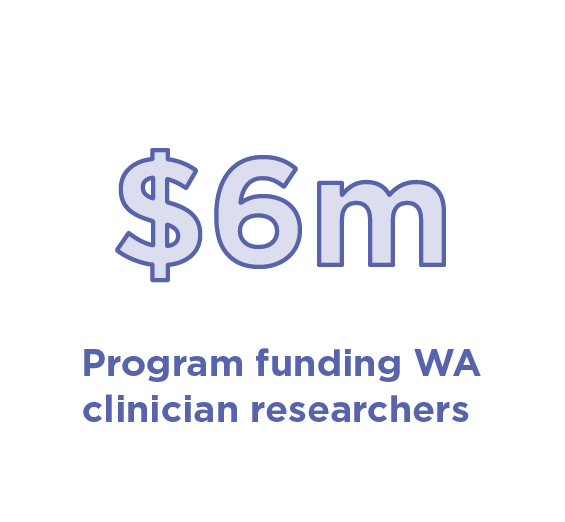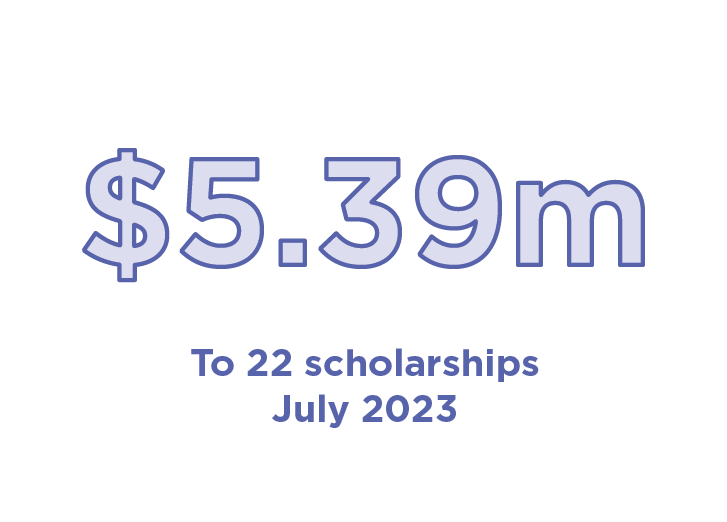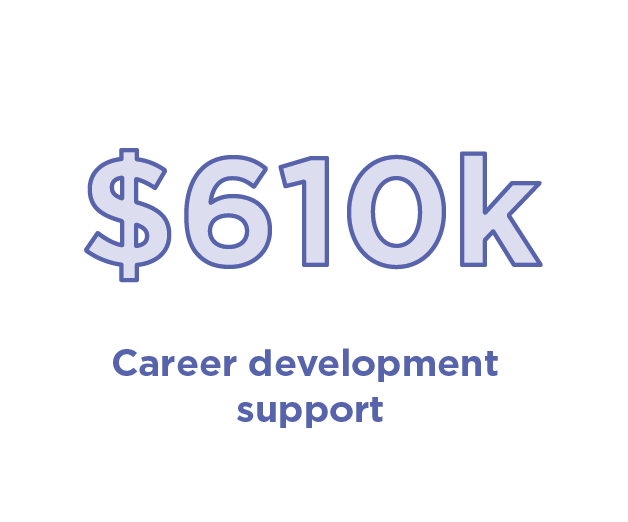Western Australian Health Translation Network is an NHMRC-accredited Research Translation Centre. We collaborate to deliver research-informed healthcare and training. The below case studies highlight our work in translating research into better health outcomes and building capability across the system.
Case studies on this page:

Case studies from all Research Translation Centres are available from Impact and outcomes.
Developing, re-designing or adopting platforms, systems or workforce initiatives: Clinician Researcher Training Program
Challenge
Over the past 50 years there has been an increasing gap between health science discovery and clinical translation. Contributing to this is the decline in the number of front-line clinical staff with higher degree training in research. This has resulted in an increased demand on current clinical academic staff and a reduction in the academic workforce, which is essential for training the clinical workforce of the future, and for ensuring the translation of clinical research into practice.
Approach
To address this problem, the Western Australian Health Translation Network (WAHTN) convened a working group comprised of WA Universities, Health Services and Research Foundations. The working group, co-led by Professor Melinda Fitzgerald (Curtin University) and Professor Gary Geelhoed (WAHTN), held a series of meetings in 2022 with the aim to develop a unique training program for Higher Degree Research (HDR) designed for local clinicians.
In 2022, WAHTN carried out a survey among clinical staff working in WA Health Services to determine the extent and nature of financial support required by clinicians to pursue HDR studies. The resulting 375 completed surveys encompassed a broad range of career stages and various disciplines, including medical, allied health, nursing and midwifery. The surveys gathered information on the factors that motivate or impede clinicians in their decision to undertake HDR studies.
Feedback from survey participants highlighted the absence of a systemic mechanism to allocate time for HDR studies and provide funding to ensure financial equity, both of which created significant obstacles for HDR students.
The findings were used to develop a report entitled 'Higher Degrees in Health Sciences: A Proposal for a Strategic Partnership between WA State Government, Universities, Metropolitan Health Services, and Research Foundations in Perth'.
The report was submitted to the WA Department of Health, Office of Medical Research and Innovation and resulted in the WA Future Health Research and Innovation Fund announcing a $6 million ‘Clinician Researcher Training Program’.
Significance
This $6 million program builds the clinician researcher workforce by providing scholarships for clinicians to undertake a clinically focused degree by research at a WA University. In July 2023, $5.39 million was awarded to 22 clinicians across WA Health Service Providers and Public Private Partnership Providers. $610,000 was also allocated to fund a capacity building and career development pool which applicants may apply to for funding throughout their scholarships.
This program represents a significant investment in the future of clinician researchers in WA which in turn will improve research being done that aligns with our Health Service Providers strategic and health priorities.



Value-add of centre
WAHTN was able to bring together the Universities, Health Service Providers and Research Foundations to workshop a viable solution to the clinician researcher problem that would work within the WA context. WAHTN facilitated these workshops and conducted vital research that informed the bid for funding of this program.
Reach
This program has benefited clinician researchers from across WA and will build WA’s research capability and capacity.
Additional benefits stem from the research itself whereby clinicians are researching solutions to important health problems such as suicide prevention, optimising patient flow in an emergency department from an Allied Health perspective, and implementing an Aboriginal informed multidisciplinary healthy lifestyle program.
Next steps
The Clinician Researcher Training Program has been relaunched for 2026 enrolment, attesting to the success of the first round.
WAHTN will continue to advocate for a continued source of funding to enable additional Clinician Researchers to undertake Higher Degree Research (HDR).
Providing better care: National Wound Care Initiative
Challenge
Wound care is a serious health issue, affecting 400,000 hospital and residential care patients and costing Australia at least $3.5 billion a year.
In response to a direct request from the Minister for Health and Ageing, the Australian Health Research Alliance (AHRA) agreed to undertake a targeted research initiative in wound management in Australia.
The Initiative was jointly coordinated by the Western Australian Health Translation Network (WAHTN) and Health Translation Queensland (HTQ), and involved 4 streams of work:
- Ascertaining the actual costs of wound care
- Updating the 2016 Australian Standards for Wound Prevention and Management
- Training and Education in Wound Care
- A coordinated National Program of Research.
Approach
WAHTN led Streams 1 and 2.
Stream 1: In collaboration with WAHTN Partner Silverchain and HTQ, WAHTN undertook a survey to determine the number and types of wounds and their treatment costs (consumables and labour) in a sample of Australian Hospitals, Residential Aged Care Facilities (RACFs), General Practices (GPs) and community settings.
Data from 21,189 clients with 49,234 wounds treated by Silverchain were used to determine the mean and median costs of consumables and labour to treat wounds. With biostatistician and health economist input sourced from the WAHTN partnership, the cost to treat all wounds surveyed in the four cohorts were modelled against Silverchain’s 2020/21 data.
Stream 2: WAHTN, in partnership with Wounds Australia, developed the 4th Edition of the Australian Standards for Wound Prevention and Management (2023), which build on Wounds Australia’s previous 3 editions. The process was overseen by a national panel of wound management experts and reviewed by relevant stakeholders across Australia.
Significance
Stream 1: The study demonstrates the significant burden of wound care in Australia and provides insight into strategies to reduce this burden and support best practice in wound care. This work is published in ‘Wound Practice and Research’ (DOI https://doi.org/10.33235/wpr.31.1.17-18).
Stream 2: The updated Standards provide a contemporary, evidence-based framework for delivery of best practice in wound prevention and management to facilitate high quality and safe clinical practice that optimises outcomes for Australians with, or at risk of, wounds. This Edition contains 2 new standards on wound prevention and the use of digital technology in wound care, including telehealth.
Value-add of centre
WAHTN provided the funding, leadership and capacity essential for conducting this work, without which this critical program of work may not have occurred.
Reach
Stream 1: The research was awarded a Wounds Australia Literary Award 2024, which acknowledges outstanding articles published in the Wound Practice and Research journal. The research has been presented to the Federal Minister for Health and is currently before Treasury to inform reimbursement of wound treatment costs.
Stream 2: The updated Australian Standards for Wound Prevention and Management were formally launched at the Wounds Australia Wound Forum Breakfast held at Parliament House, Canberra, in September 2023. The Standards are available on the Wounds Australia website.
Next steps
Continue to work with AHRA, Wounds Australia, and the Australian Government to support a data informed comprehensive reimbursement scheme for wound care based on best practice.
Meeting the needs of your end-users in your population: Consumer and Community Involvement Initiative
Challenge
Consumer and community involvement brings a unique perspective to all areas of research including planning, policy, funding, evaluation and reporting. While extensive research in Australia and internationally has provided compelling evidence that the involvement of consumers in health and medical research achieves benefits, many researchers and organisations still require guidance on how to meaningfully involve consumers.
Approach
The Western Australian Health Translation Network (WAHTN) recognised the need for practical, accessible information about how meaningfully to involve consumers and community in health and medical research. With funding from the Australian Government Department of Health, Disability and Ageing under the Medical Research Future Fund (MRFF), WAHTN developed and published a step-by-step guide entitled 'Involving Consumers in Health and Medical Research: A practical handbook for organisations, researchers, consumers and funders'.
This Handbook recognises 4 key stakeholders in the consumer and community involvement ecosystem: organisations, researchers, consumers and funders. The unique symbiotic relationship between these stakeholders is at the heart of successful consumer involvement. The Handbook and its accompanying quick guide flip chart were disseminated as hard copies and PDF versions on the WAHTN website (DOI: 10.26182/bhz4-gn61).
The Handbook formed the basis of several new online consumer and community involvement resources. In collaboration with, and with funding from, The Eastern Health Foundation (Victoria), the Handbook was used as a guiding document to co-develop and test a consumer and community involvement Audit Tool.
This tool can be used by organisations, researchers, consumers and funders to ascertain the extent and nature of consumer and community involvement in their organisation and research activity. More recently the Handbook has been developed into an interactive online course, How to Involve Consumers in Health and Medical Research, to extend its reach and accessibility.
Significance
The Handbook, Quick Flip Guide, consumer and community involvement Audit Tool and online course represent a suite of resources that allow users to easily access and learn about successful embedding of consumer and community involvement in their organisation
Value-add of centre
WAHTN and the Australian Health Research Alliance (AHRA) drew on the vast experience of the partnership to conceive, design and publish these consumer and community involvement resources.
Reach
The Handbook, Quick Flip Guide, consumer and community involvement Audit Tool and online course are freely available Australia-wide and are aimed at getting the consumer and community voice into how health research is designed, delivered and translated.
The Handbook PDF page on the WAHTN website has been viewed over 5,500 times since its launch in November 2021.
Next steps
WAHTN will continue to work closely with our AHRA colleagues to promote best practice consumer and community involvement in health and medical research, including contributing to the development of a national web-based consumer and community involvement themed Research Knowledge Hub as part of the MRFF funded 'Consumer and Community Involvement; Implementation Research for Impact (CCIRI)' project. WAHTN consumer and community involvement resources will be made available through this hub.

